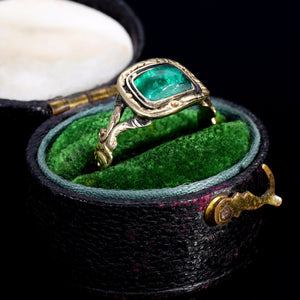Synthetic and Imitation Gems Throughout History
Long before the advent of modern gemmology, jewellers and artisans devised clever ways to mimic the sparkle of precious gems. From glass “paste” pieces in Georgian brooches to early lab-grown rubies, the world of antique and vintage rings is rich with examples of synthetic and imitation gems. Understanding these materials helps collectors appreciate both genuine treasures and the craftsmanship behind historic faux jewellery.
1. Early Imitations: Paste and Glass Gems
 The Antique Georgian 1822 Foil Backed Green Paste Ring
The Antique Georgian 1822 Foil Backed Green Paste Ring
“Paste” refers to high-quality lead glass cut to imitate diamonds, emeralds and other stones. Popularised in the 18th century, paste jewellery featured:
- Georgian and Victorian Pieces: Sets of matching paste stones in rings, brooches and pendants.
- Craftsmanship: Complex faceting and setting techniques that enhanced the glass’s brilliance.
2. Turn-of-the-Century Advances: Early Synthetics
 The Antique Victorian Synthetic Ruby and Diamond Boat Ring
The Antique Victorian Synthetic Ruby and Diamond Boat Ring
In 1893, Auguste Verneuil developed the flame-fusion method, producing the first synthetic rubies and sapphires. Key milestones include:
- Verneuil Process: High-temperature fusion of aluminium oxide, yielding near-flawless synthetic corundum.
- Impact on Jewelled Rings: From the early 20th century, synthetic stones began appearing in both new and repair work on antique settings.
3. Mid-Century Imitations: Rhinestones and Synthetic Quartz
By the 1930s–1950s, new materials emerged:
- Rhinestones: Crystal glass with foil backing, popularised by designers such as Chanel for statement costume rings.
- Synthetic Quartz: Hydrothermal and melt-growth methods produced clear or coloured quartz pebbles used in bold, mid-century designs.
4. Modern Lab-Grown Gems
Advancements in the latter 20th century made synthetic versions of almost every major gemstone:
- Synthetic Diamonds: High-pressure, high-temperature (HPHT) and chemical vapour deposition (CVD) methods.
- Gem-A and Industry Standards: Rigorous testing ensures clear distinction between natural and lab-grown stones, even in vintage ring restorations.
5. Distinguishing Imitations in Antique and Vintage Rings
Collectors should be aware that many period pieces incorporate imitation gems:
- Examination Methods: A jeweller’s loupe, refractometer and observation of inclusions often reveal glass or synthetic origins.
- Value Implications: Paste and early synthetics have their own collectible appeal but differ markedly in market value from natural gems.
6. The Collectable Appeal of Imitation Jewellery
The Antique Georgian Paste and Quartz Silver Set Ring
Despite lacking natural origins, antique paste and early synthetic gems hold unique charm:
- Historic Significance: They reflect the technological and fashion trends of their time.
- Design Variety: Bold, ornate settings often accompany imitation stones in period rings.
Conclusion
From lead-glass paste of the Georgian era to modern lab-grown diamonds, the history of synthetic and imitation gems is woven into the story of jewellery itself. Whether you cherish a genuine antique diamond ring or a sparkling paste piece, understanding these treatments adds depth to your collection and appreciation ofantique and vintage rings.



